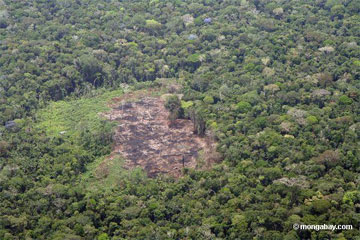Small Amazon farmers especially vulnerable to climate change
Small Amazon farmers especially vulnerable to climate change
Rhett A. Butler, mongabay.com
February 19, 2008
|
|
Communicating the impact of climate change to small farmers in the Amazon will be key in helping them adapt to higher temperatures, more frequent and intense drought, and greater incidence of forest fires forecast for the region, according to a paper published in Philosophical Transactions of the Royal Society B.
Conducting surveys in the Amazon state of Para, Indiana University anthropologists Eduardo S. Brondizio and Emilio F. Moran found that small farmers had poor recollection of the severe el Ni?o-induced drought of 1997-1998, helping explain why they had failed to adapt their cultivation methods to the increased risk of drought. Brondizio and Moran attribute the lack of understanding to the influence of migration and family turnover in the region.
 Small-holder clearing in the Amazon. Photo by Rhett A. Butler |
“We found that for most farmers, memories of extended drought tend to decrease significantly after 3 years,” write the authors. “Over 50% of the farmers interviewed in 2002 did not remember as
significant the El Ni?o Southern Oscillation (ENSO) drought of 1997/1998, one of the strongest on record. This helps explain why approximately 40% of the farmers have not changed their land-use behaviours in the face of the strongest ENSO event of the twentieth century.”
While small farmers are vulnerable to drought, flooding and accidental fire associated with climate change, they have advantages over the large-scale mechanized operators when it comes to adaptation. Whereas industrial farms are locked into certain crops and cultivation methods by high capital cost structures, small farmers can modify their agricultural practices within a short time frame to adjust to changes. Still many small farmers haven’t recognized the need to change their land-use behavior in response to larger climate shifts in the region.
Brondizio and Moran suggest three steps to help small farmers adapt to climate change, including more micromet stations for collecting “data that are locally relevant and that can inform climate models and forecasts at a finer spatial resolution”; better communication and outreach to small farmers; and encouragement of greater participation of farmer organizations in “the production of scientific and reliable information, rather than be treated only as consumers of such information.”
Given budget constraints, the authors propose a system of low cost micromet stations that would both improve data collection and engage local students in scientific processes.
Eduardo S. Brondizio and Emilio F. Moran at al (2008). Human dimensions of climate change: the vulnerability of small farmers in the Amazon [FREE OPEN ACCESS]. Phil. Trans. R. Soc. B, DOI: 10.1098/rstb.2007.0026